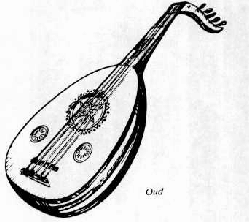| |
|
| |
|
|
| |
The
identifying link of a people may be found
not only in their language, but in their
music as well. Throughout their long and
illustrious history, the Arabs have been
lovers of music in its various forms.
Music is an integral part of daily life
in the Arab world and sensibility to its
sounds and tones is deeply rooted in the
Arab personality.
Musical tradition in the Arab world is
very old, dating back to the simple
sing-song recitations of tribal bards in
pre-Islamic days, usually accompanied by
the rababa, a primitive two-string
fiddle. As they spread out into the
Middle East and North Africa in the
seventh and eighth centuries A.D., the
Arabs quickly added the rich and
complicated scales and tones of Indian,
Persian and Byzantine music and developed
a unique form that has persisted to this
day with only minor changes.
In that sense, Arabic music is a
remarkably enduring art form which, after
centuries of competing cultural
influences, has retained an overall
unity. Many of its sounds are alien to
western ears, but the melodies have great
emotive power for Arabs who can recognize
the variations in musical styles, from
the famous maqaam of Iraq to the 'nuwashahat,
a form of singing developed in Arab
Spain during the Middle Ages and still
used today.
For several centuries, Arab rulers from
Baghdad to Cordoba were famed for their
patronage of music and musicians. Their
courts boasted full orchestras for
entertainment, while noted musicians
competed for the ruler's favor. |
|
| |
|
|
|
|
| |
|
|
| |
The music
of the Arabs gradually influenced the
West. Masters such as Bartok and
Stravinsky composed works with detectable
eastern or Arabic influences. The western
world inherited not only the structure
and tabulation of Arab music but, also,
many of its instruments.
The leading musical instrument in the
Arab takhet (orchestra) is the 'oud.
It has a half pear-shaped body with
stripes on its shell and a right angle
keyboard. It has twelve strings (six
pairs) and is played with a plectrum,
often the sharpened quill of an eagle.
The word 'oud comes from the
Arabic word meaning wood. This instrument
has a long history. Pictures of 'oud-like
instruments have been discovered on stone
carvings in ancient Egypt and
Mesopotamia. Persians and Indians played
it in ancient days. It was the Arabs,
however, who perfected the 'oud, gave
it its name, and passed it on to the
western world. |
|
| |
|
|
|
|
| |
|
|
| |
|
|
| |
The 'oud reached
Europe during the Middle Ages to replace a
plucked instrument, the giltern. In Italy,
the 'oud became il lulo, in
Germany, lauge, in France, le luth, and
in England, the ~uIe. As music became more
complex, with the introduction of chord patterns
in the thirteenth century, alterations in the
technique of playing the 'oud as well as
modifications in its construction were applied.
These changes brought its sound close to that of
the vihula, a form of Spanish guitar. In
the sixteenth and seventeenth centuries, the 'oud
was very popular in Europe as a solo
instrument and as a part of orchestra ensembles.
By the middle of the eight- |
|
| |
|
|
|



